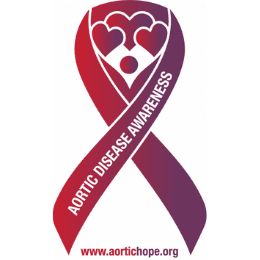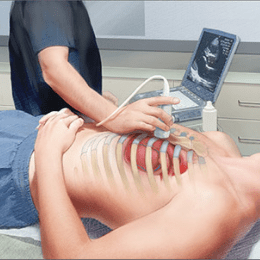To be aware is to have consciousness, recognition, or a realization of a fact or reality. An awareness allows us to encounter knowledge that was once unknown or almost kept as a secret from us. This month, we want to remove the blinders, shed light on, and enlighten our community about aortic diseases.
 Join us in recognizing Aortic Disease Awareness Month and highlighting September 19, Aortic Disease Awareness Day. A snow leopard is the visual elected to represent this, at times, quiet disease. Timo Söderlund co-founder of Global Aortic Awareness Day, helps us understand why the snow leopard. He details that the animal is rare, as are aortic conditions, and possesses similar characteristics, “silent and hard to find.”
Join us in recognizing Aortic Disease Awareness Month and highlighting September 19, Aortic Disease Awareness Day. A snow leopard is the visual elected to represent this, at times, quiet disease. Timo Söderlund co-founder of Global Aortic Awareness Day, helps us understand why the snow leopard. He details that the animal is rare, as are aortic conditions, and possesses similar characteristics, “silent and hard to find.”
We know the aorta has the vital job of transporting oxygen-rich blood from the heart to the rest of the body. When the inner layer of the blood vessel becomes weak and thin, it can break and cause blood to flow into the cavity between the inner and outer layers of the aorta. The result is a bulging or ballooning of the vessel known as an aneurysm. An aneurysm can tear or rupture—this is called an aortic dissection—which, under certain conditions, can occur when there is no aneurysm present.
Though both conditions are rare and affect only three out of 100,000 people each year, according to The Society of Thoracic Surgeons. Both take an enormous number of lives due to the level difficulty involved in diagnosing them. The US National Center for Health Statistics reports about 15,000 aorta-related deaths each year.
The diagnosis complexity is due to the various symptoms that accompany aortic aneurysms and dissections. In addition, many cases are not associated with any chest or abdominal pain, present unreliable physical exam findings, and lack any specificity in presentation. This creates a barrier to saving lives as early detection is required to reduce the mortality rate, particularly before an emergency occurs.
One modality we believe can change the current stance and statistics associated with aortic diseases is point-of-care ultrasound (POCUS). POCUS has gained reputation in the emergency room for providing rapid and accurate diagnostics at the bedside of patients. This hand-held device is already aiding in reducing care time, medical costs, and fatalities as it pertains to other ailments. There is no real explanation as to why we cannot see the same hold true for diagnosing aortic conditions.
The CPC Emergency Medicine includes an article presenting a case of a 67-year-old patient found to have a Stanford Type-B dissection, and his life was preserved due to the immediate actions the emergency room team attending to him were able to take. Upon arrival, he complained of a sharp and burning pain in his right leg. He had no chest pain, all vitals were normal, and his neurologic exam showed no signs of concern.
 Due to the inability to find the source of the pain, his care team performed a POCUS evaluation. They combined a transthoracic echocardiogram (TTE) and abdominal aorta ultrasound and discovered via POCUS an undulating intimal flap in the abdominal aorta. With this find, this distressed patient was able to obtain treatment promptly. His care team went into action and began blood pressure controls and administered a CT scan which validated a Stanford Type-B dissection. A thoracic endovascular aortic repair was performed, and the patient recovered without issue.
Due to the inability to find the source of the pain, his care team performed a POCUS evaluation. They combined a transthoracic echocardiogram (TTE) and abdominal aorta ultrasound and discovered via POCUS an undulating intimal flap in the abdominal aorta. With this find, this distressed patient was able to obtain treatment promptly. His care team went into action and began blood pressure controls and administered a CT scan which validated a Stanford Type-B dissection. A thoracic endovascular aortic repair was performed, and the patient recovered without issue.
We believe that more cases can end with the same positive result. The immediate availability of POCUS is one of its most beneficial qualities. It is an advantage that directly correlates to diagnosis time. Identifying aortic diseases is a unique challenge for physicians. The high fatality rate that accompanies the condition calls for prompt decisions, actions, and treatment. However, there remains a gap caused by its difficulty to diagnose.
We genuinely believe that point-of-care ultrasound can help change the current narrative. It is all the more reason to join our community. As we reflect on Aortic Disease Awareness Month and pay homage to the day, let’s learn how we can help. Visit Aortic Hope for more information on aortic support and check out our POCUS certificate and certification programs that empower our community to advance patient care every day.
References:
Aortic Disease Awareness Day. The Marfan Foundation. https://info.marfan.org/adadhome. 2019.
Aortic Disease Awareness Month. The Society of Thoracic Surgeons. https://ctsurgerypatients.org/aortic-disease-awareness-month. 2019.
Point-of-care Ultrasound Diagnosis of an Atypical Acute Aortic Dissection. CPC Emergency Medicine. https://www.ncbi.nlm.nih.gov/pmc/articles/PMC6230344/. 2018.
Through my eyes: Aortic dissection. Medical News Today. https://www.medicalnewstoday.com/articles/323098.php. 2018.
Looking for additional inspiration? Sign up for our POCUS Post™ newsletter to receive monthly tips and ideas.





















